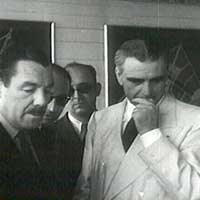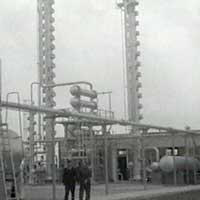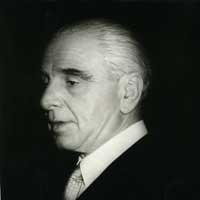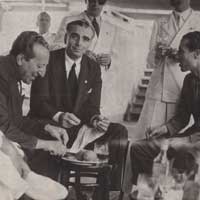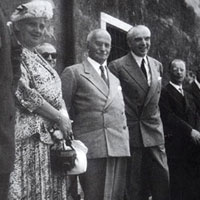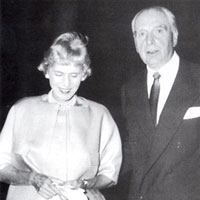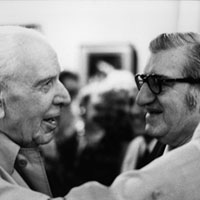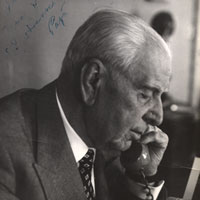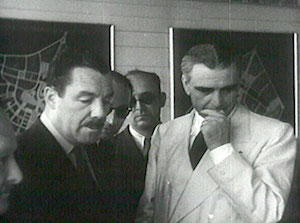 Vittorio Cini at the EUR in Rome After completing secondary school in Venice, he studied business at the Institut International Schmidt in St Gallen, Switzerland (1903) and the following year moved to London to work in banking. In 1905 he returned to Italy to join his father's business, where he gained his first entrepreneurial experience. Founded in 1885, the firm specialised in construction (road, rail, river and maritime infrastuctures) and interdependent affiliated sectors (extraction of raw materials, supply and transport on company-owned means, storage in warehouses and building-sites, workshop and plant repairs). In 1910 Cini took over management of the firm and founded a sister company (Ditta Vittorio Cini, based in Chioggia), with which he gained recognition by winning important contracts.
Vittorio Cini at the EUR in Rome After completing secondary school in Venice, he studied business at the Institut International Schmidt in St Gallen, Switzerland (1903) and the following year moved to London to work in banking. In 1905 he returned to Italy to join his father's business, where he gained his first entrepreneurial experience. Founded in 1885, the firm specialised in construction (road, rail, river and maritime infrastuctures) and interdependent affiliated sectors (extraction of raw materials, supply and transport on company-owned means, storage in warehouses and building-sites, workshop and plant repairs). In 1910 Cini took over management of the firm and founded a sister company (Ditta Vittorio Cini, based in Chioggia), with which he gained recognition by winning important contracts.
Between 1918 and 1919 Cini began an involved process of disinvestments and re-investments, after which he reorganised the business to provide a solid financial structure for his initiatives. Having verified the impact of transport on the volume of business and in response to increasing traffic and the expanding international market, he extended his operations in the maritime-shipbuilding sector. He backed the start-up of various shipping companies and began taking control over the management of other shipping and maritime-insurance companies, broadening the financial and management efforts which would conclude between the twenties and thirties. This growth culminated in 1932 when the Venice-based 'Compagnia adriatica', a fusion of six shipping companies under Cini's management, practically took control of traffic in the Adriatic. From there it was easy to join with other affilliated shippers in dominating traffic in the Eastern Mediterranean and the East. The result of this expansion was the founding of the 'Società Italiana di Armamento Sidarma' in Fiume in 1938.
Cini's initiatives after 1919 are best understood in light of his participation in the 'Venetian group' headed by Giuseppe Volpi, whom Cini often described as 'a brother and a friend'. In 1920 Cini began managing the 'Società italiana costruzioni (Sitaco)', which was about to start building in the urban area of Marghera next to the industrial zone, and the 'Credito industriale (Credindustria)', which was both the group's holding and credit company. On behalf of the 'Venetian group' he got involved in sectors that showed potential for working together: development of Marghera's industrial zone; expansion of electrical works (Sade); control of water works; textiles (Cotonificio veneziano); transport (shipping, Compagnie internationale des vagons-lits, and the company that built and operated the railways); radio and telecommunication; iron and steel works, metallurgy and mechanics; tourism (Ciga). The full extent of this diversification can be gauged by the sheer number of companies in whose finance and management Cini maintained a conspicious role as president or advisor (29 groups in 1930-1931).
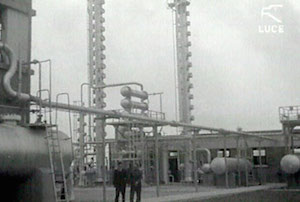 Porto MargheraIn 1921 Cini was appointed special commissioner for the reorganisation of the Ilva iron and steel works and in slightly over a year the company was able to buy back its own plants. In March 1935 he succeeded O. Sinigaglia as president, a position he held until 1939. In September 1927 Mussolini put Cini in charge of studying and providing provisions for the political, social and economic organisation of the province of Ferrara, an area that remained tricky for the Fascist regime. Cini was appointed Senator (XXI category) on 23 January 1934.
Porto MargheraIn 1921 Cini was appointed special commissioner for the reorganisation of the Ilva iron and steel works and in slightly over a year the company was able to buy back its own plants. In March 1935 he succeeded O. Sinigaglia as president, a position he held until 1939. In September 1927 Mussolini put Cini in charge of studying and providing provisions for the political, social and economic organisation of the province of Ferrara, an area that remained tricky for the Fascist regime. Cini was appointed Senator (XXI category) on 23 January 1934.
In October 1936 Cini was considered as a possible successor to A. Beneduce as president of the Institute for Industrial Reconstruction (I.R.I.). Mussolini and Cini, however, were concentrating on another assignment, the office of General Commissioner of the Universal Exhibition of Rome (E 42) planned for 1942. The appointment was approved the following 31 December.
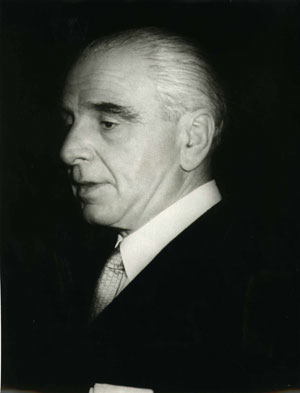 Vittorio Cini The Second World War marked a period of contradictions and decisive turning points for Cini. After receiving the title of Count of Monselice on 16 May 1940, he was appointed Minister of Communications in the governmental reshuffling of 5 February 1943.
Vittorio Cini The Second World War marked a period of contradictions and decisive turning points for Cini. After receiving the title of Count of Monselice on 16 May 1940, he was appointed Minister of Communications in the governmental reshuffling of 5 February 1943.
After the Second World War Cini's interests turned once again to shipping, in particular to the enterprises of the Sidarma company. It was the electrical industry, however, that engaged him most fully, as president of the SADE. Between 1953-1962 the company consolidated a vast number of the thermo-electric and hydro-electric plants in the Veneto and Friuli, ranging from the thermo-electric stations of Marghera, Fusina, Porto Corsini and Monfalcone to the hydro-electric dams of Cellina, Cordevole, Piave and Vajont. Having ceded its installations to the state-run electric company in accordance with the law of 6 December 1962, in August 1964 the SADE decided to merge with the Montecatini company, thereby anticipating its fusion with Edison.
Vittorio Cini | Biography | Entrepreneur | Patron | Collector | Fondazione Archivio Vittorio Cini
Attachments
- - Depliant "Vittorio Cini"
- - From the Italian Biographical Dictionary "Vittorio Cini" by Maurizio Reberschak

